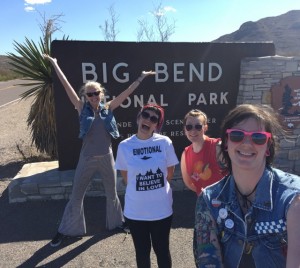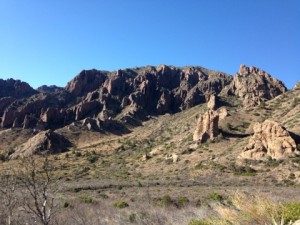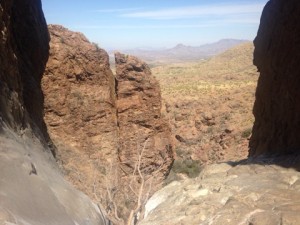During the month of April, I went on a four day camping trip with three wonderful friends of mine to Big Bend National Park. The trip started out rocky, and the car broke down an hour into our trip. Fortunately, we were saved by the always prepared, Ms. Swope (see last post). The next day we were at it again and 8 hours later, we found ourselves in awe at the expansive desert of Big Bend. It was everyone’s first time at Big Bend, but we were all too prepared.
This was my second time camping but having done it for the first time just three weeks prior, I felt relatively ready. The weather during our time there was unusually hot for so early in April, around 90 degrees each day. Although being a Texan, I can assure you that physically 90+ degrees can be easily handled. What makes the difference however, is the lack of shade the desert provides. Just sun, shining down, with no give, for every hour of daylight. It’s intense. The moment I stepped back into a desert climate, I felt what I had felt in Death Valley, empty. Despite the grand landscape the desert provides, its the lack of trees and animals that really changes my mental and emotional well-being. (See first picture for reference to my sappy emotions.)
So why did I take trips to these biomes if I’m not their biggest fan you ask? Let’s attribute that to fate…
Now let’s backtrack, my blog started out in February, where I stated that my initial focus would be on women in conservation and how gender influences conservation efforts. Well, here’s what I’ve noticed and researched. According to the International Labour Organization, the wage gap between women and men has shortened since 1979, when women earned 62% compared to their male counterparts to today, where women earn a whopping 81% (yipee?). I also found some other interesting statistics. “Women surpass men on education attainment among those employed aged 25 and over: 37.1 percent of women hold at least a bachelor’s degree compared to 34.9 percent for men (International Labour Organization)”. Furthermore, when looking at rates of employment, women are relatively close in percentage to men’s rates. There are also several categories of work where women’s participation surpasses men’s. However, two sectors: construction and the ‘professional, scientific, and technical’ sector still have men’s participation outnumbering women’s. Construction has 8.9% female participation, and the ‘professional, scientific, and technical’ has 43.2%. I mention this because my initial hypothesis upon starting the blog was that the inequality in participation rates between men and women in the field of conservation were going to be much larger than they actually are. By this, I mean that while participation rates aren’t completely equal (we don’t live in a perfect world) they are relatively close and from what I’ve noticed from visiting National Parks, there is no observable difference in participation rates among females and males. Females visit national parks and nature in general, at the same rates as men.
So did I just debunk my hypothesis? Well, not exactly.
Upon further research, I’ve found that gender inequality is most influential in leadership sectors.
“In 2009 only 24 percent of CEOs in the US were women and they earned 74.5 percent as much as male CEOs…. The Harvard Business School, in conjunction with Catalyst, recently released a research report regarding the level of Corporate Social Responsibility (CSR) of Fortune 500 companies with respect to the amount of women on the companies’ Boards of Directors and serving as Corporate Officers. Of the Fortune 500 companies, in 2007, companies with three or more women on the Board of Directors averaged 28 times more money in philanthropic donations than those with no women, according to the report. Also, companies with 25% or more women in leadership positions as Corporate Officers averaged 13 times more philanthropic donations than those with none (Catalyst and HBS 2011) (National Labour Organization)”. So basically what this research found is that higher percentage of leadership among females influences where donations go or if donations take place at all.
In an article addressing if developmental initiatives influence local attitudes toward conservation, researchers found a difference in attitude among men and women. When asked if they were in support of tiger conservation, over 50% of all respondents said yes, however support was much higher among women, who in turn cited the “tiger’s innate right to life” as the main reason for their support (Arjunan) . Likewise in another article, the “failures of conservation” is argued to be “attributed to poor involvement of women”. The article goes on to state that in order to “improve the role of women in conservation, we need to better understand and target the reliance of women on natural capital, involve women more effectively in natural resource governance, and build the capacity of women in conservation science and its application (Sodhi)”.
To sum all of this up, women have extremely low rates (compared to men) in leadership positions. Women also have a different perspective towards nature than men do. This is played out time and time again, and even Park Ranger Laura discussed her years of observation regarding behavioral differences in men and women towards nature.
Now, let me be clear: in no way am I bashing men’s leadership or attitudes toward the environment. What I am trying to do however, is bring attention to the fact that there is 50% men and 50% women on earth, yet only 25% women in leadership positions. Back to the Lorax, there’s a bigger problem at hand than any of this and it’s characterized my two camping trips, CLIMATE CHANGE. It’s causing increasingly drastic weather patterns, deserts are growing, and species are going extinct. So if there’s no noticeable difference in participation rates between men and women’s enjoyment of these parks, why is there such a huge gap in the decision making process? It’s clear from research and observation that women and men have different perspectives towards nature, so why is one prevailing?
…..
On our way back from the trip, we drove through one of the scariest storms I’ve ever seen. We started out the drive during a lightning storm, which lasted for 3 hours before the hail came. The hail was continuous and was soon accompanied by rain. As we were driving through desolate West Texas, we saw funnels forming in the distance. Luckily, we made it home safely through the storm. The next day I got a call from my parents who told me the several windows were broken by baseball sized hail, and that one of their cars was completely damaged. These incidents were not normal, they are the result of increasingly harsh weather patterns caused by climate change. As several scientists and our President has said “the single greatest threat to our planet is climate change”, so maybe, just maybe, it’s time to allow a new perspective to govern our relationship to nature, if, as a planet, we want to heal and deal with the damage we’ve created.
Works Cited
“Gender Inequality and Women in the US Labor Force.” Gender Inequality and Women in the US Labor Force. International Labour Organization, 23 Nov. 2011. Web. 06 May 2016.




